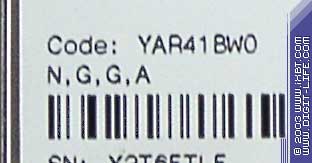 |
||
|
||
| ||
If you remember, the situation with Maxtor DiamondMax Plus9 hard drives is quite complicated. According to the manufacturer, hard drives of this line have a record density of 80 GB per platter. But in reality it can be different. The record density makes 60 GB per platter (80 GB is 1.5 truncated platters) for drives of the firmware version YAR41VW0, and it depends on a disc size for the firmware version of YAR41BW0 - 80 GB per platter for 80 and 160 GB drives, and 60 for 60 and 120GB drives. The drives can have a size of 60, 80, 120 and 160 GB (a 200GB was also recently launched). The codename is 6Yxxxz0, where xxx is size, z is disc type (L - ordinary with a 2MB buffer, P - with a 8MB buffer, M - with Serial ATA interface). The full specs are given in this table. Earlier I tested the 60GB drive, 6Y060L0, and 80GB drive with a 8MB buffer - 6Y080P0. Both have the firmware version of YAR41VW0 and 60GB platters. Now I've got a 80GB of YAR41BW0 and a 80GB platter. Let's see what's this full function baby is able of. 
 Outwardly, it differs in the model name and firmware version.  TestsThe test system is standard.
The test suite is standard as well.
For comparison we have taken the scores of the 6Y060L0 Drive, 60GB, with a 60GB platter and a 2MB buffer. We thus compare two discs with two heads and full-size (not truncated) platters. The drives were tested in four modes - with presets (acoustic level = fast), and with acoustic management off with drive connected to the ATA/133 controller and to the internal ATA/100 controller. When the scores for acoustic management on and off coincided I left the scores only for the Off mode. Ziff-Davis WinBench 99 / HDTach 2.61
The maximum linear read speed of the 80GB is noticeably higher. The diagram is almost ideal. The average read/write rates are therefore higher as well. Moreover, the access time is lower. The performance gain is obvious. In the tests above the new version is undoubtedly faster. Let's have a look at the synthetics. Intel IOMeterThe scores are higher at the low and average load. In the random access test the 80GB Drive wins in case of the linear load (at the expense of the lower access time), but falls behind its competitor at heavier loads. The new drive has no problems with the random writing. All in all, the drive with the full 80GB platter has outscored its "crippled" brother. Finally, let's see how the new-comer copes with other models. Perfect score! The Maxtor shares the first place with the Seagate Barracuda 7200.7 in the maximum read speed test. And even outdoes the latter in the average read speed. The average write speed is good as well. Its access time is higher only than that of the leading IBM drive. Again, the scores are magnificent. I can say that the Maxtor 6Y080L0 takes the lead. But it still crawls behind in the Intel IOMeter... in spite of the increased results. The results are average, and the new firmware version doesn't help much. ConclusionWell, this full-size drive certainly looks stronger than the model with
a 60GB platter. However, it fails in the battle against the leaders in
the Intel IOMeter. But you should admit that the Maxtor DiamondMax Plus
9 with the firmware version YAR41BW0 is a successful solution and can be
an optimal purchase in many cases.
Write a comment below. No registration needed!
|
Platform · Video · Multimedia · Mobile · Other || About us & Privacy policy · Twitter · Facebook Copyright © Byrds Research & Publishing, Ltd., 1997–2011. All rights reserved. |